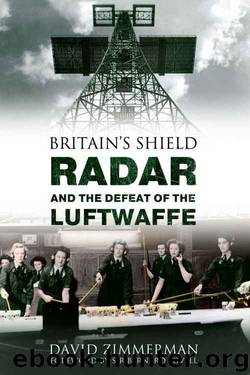Britain's Shield: Radar and the Defeat of the Luftwaffe by David Zimmerman

Author:David Zimmerman [Zimmerman, David]
Language: eng
Format: epub, azw3
Publisher: Amberley Publishing
Published: 2012-12-10T22:00:00+00:00
By the late summer of 1936 Bowen had built a transmitter which could transmit pulses at 6.7 metre wavelength. At first it was not possible to miniaturize the transmitter sufficiently to fit inside an aircraft. Bowen set up this experimental radar in the top of the White Tower at Bawdsey Manor. It was this apparatus that Dowding was shown after the disastrous demonstration of the chain radar set in September. From the ground the radar could detect targets at forty to 50 miles range, but there was no proof it would work in the air. Bowen came up with a brilliant improvisation. He decided that there was no reason the transmitter had actually to be in the aircraft; instead the airborne receiver would utilize radio pulses sent out from a transmitter on the ground. Bowen dubbed this radar RDF 1½, because chain radar was known by the code name RDF 1 and complete aircraft mounted set was dubbed RDF 2.
Testing of this hybrid radar commenced in the autumn of 1936 using a Hereford bomber which operated from the nearby airbase at Martelsham Heath. On its first flight the radar detected aircraft at between 8 to 10 miles distance. Bowen argued that RDF 1½ worked so well that it should be adopted rather than waiting for the development of a complete airborne radar system. Watson-Watt overruled him, citing serious difficulties in getting accurate range measurements unless the fighter was directly between the transmitter and an enemy bomber.
Bowen’s group was, therefore, forced to continue development of the transmitter to make it small enough to fit inside an aircraft. In March 1937, Perc Hibbard, a member of the group, was able to build a small transmitter operating at 6.7 metres. That month it was tested in the Hereford and clear signals were detected from prominent objects on the grounds, such as wharves and the cranes at Harwich, at 3 or 4 miles range.
While technically successful, better resolution was required. This involved a variety of technical issues; one of the most difficult was to push the wavelength even lower in order that adequate transmitting and reception aerials could be fitted. Using new valves imported from the United States, Bowen’s team was able to build a small transmitter which could send out pulses with the then remarkably short wavelength of 1.5 metres. The EMI receiver was modified to work with the transmitter. In the meantime the airborne radar group was given control of two Avro Anson maritime patrol aircraft.
On 17 August Dr A. G. (Gerald) Touch and Keith Woods, two members of Bowen’s group, boarded one of the Ansons for the first flight of the new radar. They received clear echoes of ships off Felixstowe at ranges between 2 and 3 miles. On learning of these results Watson-Watt sought a way to bring the breakthroughs in airborne radar dramatically to the attention of the Air Ministry. An opportunity soon presented itself when he learned of an exercise scheduled for early September in which Coastal Command
Download
Britain's Shield: Radar and the Defeat of the Luftwaffe by David Zimmerman.azw3
This site does not store any files on its server. We only index and link to content provided by other sites. Please contact the content providers to delete copyright contents if any and email us, we'll remove relevant links or contents immediately.
| Antennas | Microwaves |
| Mobile & Wireless | Networks |
| Radar | Radio |
| Remote Sensing & GIS | Satellite |
| Signal Processing | Telephone Systems |
| Television & Video |
Whiskies Galore by Ian Buxton(41941)
Introduction to Aircraft Design (Cambridge Aerospace Series) by John P. Fielding(33095)
Small Unmanned Fixed-wing Aircraft Design by Andrew J. Keane Andras Sobester James P. Scanlan & András Sóbester & James P. Scanlan(32767)
Craft Beer for the Homebrewer by Michael Agnew(18200)
Turbulence by E. J. Noyes(7983)
The Complete Stick Figure Physics Tutorials by Allen Sarah(7339)
Kaplan MCAT General Chemistry Review by Kaplan(6903)
The Thirst by Nesbo Jo(6882)
Bad Blood by John Carreyrou(6585)
Modelling of Convective Heat and Mass Transfer in Rotating Flows by Igor V. Shevchuk(6408)
Learning SQL by Alan Beaulieu(6239)
Weapons of Math Destruction by Cathy O'Neil(6220)
Man-made Catastrophes and Risk Information Concealment by Dmitry Chernov & Didier Sornette(5958)
Digital Minimalism by Cal Newport;(5707)
Life 3.0: Being Human in the Age of Artificial Intelligence by Tegmark Max(5520)
iGen by Jean M. Twenge(5387)
Secrets of Antigravity Propulsion: Tesla, UFOs, and Classified Aerospace Technology by Ph.D. Paul A. Laviolette(5336)
Design of Trajectory Optimization Approach for Space Maneuver Vehicle Skip Entry Problems by Runqi Chai & Al Savvaris & Antonios Tsourdos & Senchun Chai(5040)
Pale Blue Dot by Carl Sagan(4960)
